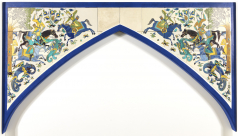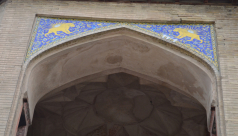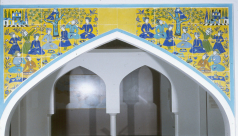Islamic art
Monthly Archive: December Isla
Safavid Tile Project IV: The Artist behind the Arches

Some of the most noticeable objects in the ROM's Wirth Gallery of The Middle East are two friezes of tiles that would have been in the spandrels of arches. These were made in Iran in the last third of the 17th century under the Safavid dynasty, probably for a palatial building in Isfahan. The ROM also has parts of other spandrel friezes, and also some stray tiles that belong to yet other friezes. In order to understand these objects more fully, ROM staff have been undertaking research on the tiles.
Safavid Tile Arch Project III: The Palace of the Stables

Written by Lisa Golombek, Curator Emeritus (Islamic Art)
Safavid Tile Project II: Rebuilding the Friezes

The ROM's Wirth Gallery of The Middle East is blessed with two complete friezes of cuerda seca tiles that would have been in the spandrels of arches. These were made in Iran in the last third of the 17th century under the Safavid dynasty, probably in Isfahan. They were bought by the ROM in 1974 by Curator Lisa Golombek together with a number of other tiles that make up parts of these friezes, or sometimes individual tiles.
Safavid Tile Project I: The Technology

Some of the most noticeable objects in the ROM's Wirth Gallery of The Middle East are two friezes of tiles that would have been in the spandrels of arches. These were made in Iran in the last third of the 17th century under the Safavid dynasty, probably for a palatial building in Isfahan. The ROM also has parts of other spandrel friezes, and also some stray tiles that belong to yet other friezes. In order to understand these objects more fully, ROM staff have been undertaking research on the tiles.
